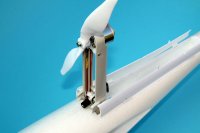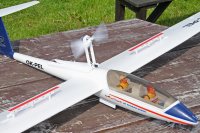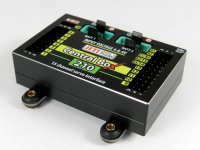On the market there are many types of electronic control systems for the retractable motor pylons. In this tutorial we will show you how to use the transmitter to control deployment of the pylon with a switch while simultaneously the engine gets blocked so that it cannot be accidentally triggered inside the fuselage.
The mechanism presented is a representative of simple hinged systems used in smaller gliders. It consists of the engine mounted on a swing arm and the servomechanism controlling the folding itself. The door is spring-loaded and closes automatically.
The uniqueness of this retractable system is that the motor brake is not set in the controller and the propeller is stopped by a braking pin as soon as it gets tilted by about 10°. This ensures both fine stopping of the propeller, and maintain the correct position for insertion into the fuselage.
Set up the transmitter according to the following instructions:
- We will use one sequencer and one logical switch out of all the transmitter functions.
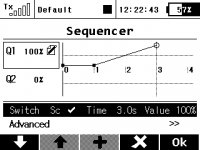 |
Activate the sequencer Q1 in the menu Advanced properties » Sequencer. This sequencer is controlled by two-position switch Sc.In the picture on the left a folding curve is depicted that lasts about 3 seconds. At the time of 0 seconds the control point with the value of -100% (pylon folded) is inserted, on the contrary at the time of 3 seconds the checkpoint with the value of +100% (pylon fully deployed) is inserted.There is a smooth transition between these values.
Now let´s move to the Advanced menu.
|
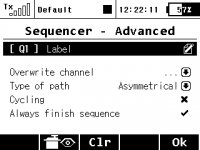 |
In the detail of the sequencer set its name (a Label column), which can be arbitrary. Then select the path type Asymmetrical (ie. it is possible to have two independent waveforms for the travel in and out) and then enable Always finish sequence.
Now get back to editing the sequencer.
|
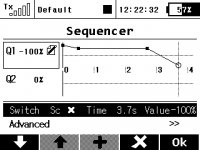 |
Now we can set the return route of the sequencer, which is activated after the Sc switch is turned off. In the time of 0.5s the fully deployed pylon moves smoothly to the value of approximately +70%, which means its slight retraction so that the braking pin is activated and it slowly stops the engine. During approx. 2-3 seconds the motor has to be stopped – after this period the pylon folds back to the fuselage (in the picture the value is -100% after the time of 3.7s).
|
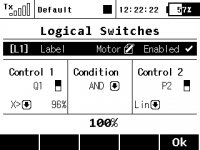 |
Further on we can learn to create the logical switch L1, which can be named eg. Engine. This logical switch will block the throttle function in the moment while the pylon starts folding. The throttle will be unblocked again when the pylon is fully deployed).
- Select the sequencer Q1, which has been created by yourselves, as Control 1. There the proportional evaluation is set (button Prop. when selecting the control) and "X>96" is a condition.
- Select the throttle stick (P2) as Control 2, where there is a proportional evaluation also set and the linear progression (Lin.) is taken as the output.
Function: In case the Q1 is fully ejected, the condition of Control 1 is fulfilled. The value of P2 control is then considered as the output of the logical switch. When the pylon starts folding (the value of the sequencer Q1 falls below 96%), the constant value of -100% is taken as the logical switch output, it means the engine is blocked and then does not start.
|
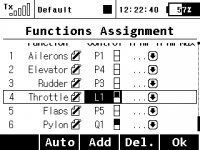 |
Assign the created logical switch to the motor function.
For controlling the pylon, a new user function "Pylon" has been created. The Q1 sequencer created by ourselves is now assigned to this function.
Put the Pylon function to any transmitter channel and test the functionality together with servos.
|
Download
Model: Glider-Pylon - Model configuration example
